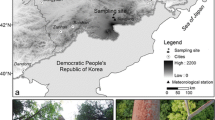Abstract
The pollen flux in coniferous and deciduous broadleaved mixed forest in the Changbai Mountains is presented in one year’s experiments. The results indicate that arboreal pollen percentages are more than 65% and pollen flux is higher than 5000 grain·cm−2·a−1, while less than 2% and lower than 1000 grain·cm−2·a−1 for shrubby pollen, and less than 20% and lower than 3000 grain·cm−2·a−1 for herbaceous pollen for most samples at different heights. The pollen assemblages are similar to those in the samples under 8 m height where Pinus and Quercus are dominant and followed by the few non-local pollen types, and Fraxinus percentages are high with a few non-local pollen types at 16 m to 32 m height as well as non-local pollen clearly increased at 40 m height. Comparisons between pollen assemblages and vegetation composition suggest that similarities are higher for pollen trap samples than for surface moss samples.
Similar content being viewed by others
References
Tauber H. Investigations of the mode of pollen transfer in forested areas. Rev Palaeobot Polyno, 1967, 3: 277–286
Andersen S. The differential pollen productivity of trees and its significance for the interpretation of a pollen diagram from a forested region, In: Birks H J B, Birks H H B, eds. Quaternary Plant Ecology. London: Cambridge University Press, 1973. 109–115
Davis O K. Pollen frequencies reflect vegetation patterns in a Great Basin (U.S.A.) mountain range. Rev Palaeobot Polyno, 1984, 40: 295–315
Jackson S T, Lyford M E. Pollen dispersal models in Quaternary plant ecology: assumptions, parameters and prescriptions. Bot Rev, 1999, 65: 39–75
Li Y Y, Zhang X S, Zhou G S. Study of quantitative relationships between vegetation and pollen in surface samples in the eastern forest area of Northeast China Transect. Acta Bot Sin (in Chinese), 2000, 42(1): 81–88
Zhou K S, Yan F H, Ye Y Y, et al. Surface pollen assemblages of different vegetation zones in the northern slope of the Changbai Mountain. In: Institute of Geology, CAS, Tongji University, eds. Quaternary Pollen Analysis and Paleo-environment (in Chinese). Beijing: Science Press, 1984. 115–122
Shen C M, Tang L Y. A preliminary study on transfer-function between pollen and Holocene climate in the area of Xiaoxing’anling Mountains. In: Shi Y F, ed. Climate and Environment of the Holocene Megathermal in China (in Chinese). Beijing: China Ocean Press, 1992. 1–18
Sun X J, Luo Y L, Tian J, et al. Pollen record of surface sediments from vertical forest zones of Changbai Mountain, Northeast China and their relations to the modern vegetation. Acta Bot Sin, 2003, 45(8): 910–916
Sun X J, Wu Y S. Modern pollen rain in needle-broad leaved mixed forest of Changbai Mountain. Acta Bot Sin (in Chinese), 1988, 30(5): 554–560
Zhao X S, Guan D X, Wu J B, et al. Distribution of footprint and flux source area of the mixed forest of broad-leaved and Korean pine in Changbai Mountain. J Beijing Forestry Univ (in Chinese), 2005, 23(3): 17–23
Zhang M, Guan D X, Han S J, et al. Climatic dynamics of broadleaved Korean pine forest in Changbai Mountain during the last 22 years. Chinese J Ecol (in Chinese), 2005, 24(9): 1007–1012
Sun Z W, Zhao S D. Community features of Tilia-Korean pine forest on northern slope of Changbai Mountains. Chinese J Ecol (in Chinese), 1995, 14(5): 26–30
Feagri K, Iversen J. Textbook of Pollen Analysis. 3rd ed. Oxford: Blackwell, 1989. 295
Li Y C, Xu Q H, Zhao Y K, et al. Pollen indication to source plants in the eastern desert of China. Chin Sci Bull, 2005, 50(15): 1631–1641
Pei X D. Multi-statistical Analysis and Application (in Chinese). Beijing: Beijing Agriculture University Press, 1990. 196–203
Wang K F, Wang X Z. Theory of Pollen Analysis (in Chinese). Beijing: Peking University Press, 1983. 13–14
Nielsen A B. Modeling pollen sedimentation in Danish lakes around AD 1800 — an attempt to validate the POLLSCAPE model. J Biogeogr, 2004, 31: 1693–1709
Van der Knaap W O, Van Leeuwen J F N, Ammann B. Seven years of annual pollen influx at the forest limit in the Swiss Alps studied by pollen traps: relations to vegetation and climate. Rev Palaeobot Polyno, 2001, 117: 31–52
Koff T. Pollen influx into Tauber traps in Estonia in 1997–1998. Rev Palaeobot Polyno, 2001, 117: 53–62
Author information
Authors and Affiliations
Additional information
Supported by the Preliminary Special Foundation for National Key Basic Research (Grant No. 2003CCA01800), the National Natural Science Foundation of China (Grant Nos. 40571166 and 40672107), Hebei Special Foundation for Ph.D (Grant No. 06547006-3) and the Key National Natural Science Foundation of China (Grant No. 40331011)
About this article
Cite this article
Xu, Q., Li, Y., Zhou, L. et al. Pollen flux and vertical dispersion in coniferous and deciduous broadleaved mixed forest in the Changbai Mountains. CHINESE SCI BULL 52, 1540–1544 (2007). https://doi.org/10.1007/s11434-007-0187-z
Received:
Accepted:
Issue Date:
DOI: https://doi.org/10.1007/s11434-007-0187-z



